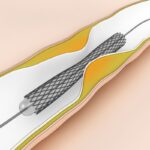Original title: Long-Term Clinical Outcome Intervention Versus Coronary Artery Bypass Grafting for Ostial/Midshaft Lesion in Unprotected Left main Coronary Artery From The DELTA Registry. Reference: Toru Nagamuna et al. JACC Cardiovascular Intervention. Article in Press Even though surgery remains the “gold standard” to treat UMCLA lesions, current guidelines have incorporated PCI as class IIa at ostium/midshaft level. The…
Fluorography reduces radiation exposure of patients and operators without affecting the effectiveness of diagnostic coronary angiography
Original title: Effectiveness of Fluorography Versus Cineangiography at Reducing Radiation Exposure During Diagnostic Coronary Angiography. Reference: Shah B et al. Am J Cardiol. 2014 Apr 1;113(7):1093-8. Coronary angiography is the gold standard for defining obstructive coronary disease. However, radiation exposure remains an unclear and unwanted risk. The aim of this study was to determine whether the new digital…
Deferred Stenting in Primary Angioplasty could reduce No Reflow Risk and Infarct Size.
Original: A Randomized Trial of Deferred Stenting versus Immediate Stenting to Prevent No-or Slow Reflow in Acute ST-Elevation Myocardial Infarction (DEFER-STEMI). Reference: David Carrick et al. J Am Coll Cardiol. 2014. Epub ahead of print. No Reflow physiopathology involves microvascular obstruction secondary to thrombus embolization, spasm or microvascular thrombosis, and happens in approximately 10% of PCI procedures. The…
Multivessel angioplasty in acute myocardial infarction improves prognosis
Original title: Acute multivessel revascularization improves 1 year outcomes in ST-elevation myocardial infarction. A nationwide study from AMIS plus registry. Reference: Raban Jeger, et al. International journal of Cardiology 2014;172:76-81 The presence of multiple vessel lesions is present in about 50% of patients referred for primary angioplasty. The accepted strategy is to treat the culprit artery even…
Best results of angioplasty with DES guided by IVUS versus angiography only
Original title: Intravascular Ultrasound-Guided Implantation of Drug-Eluting Stents to Improve Outcome. A Meta-Analysis. Reference: Jae-Sik Jang et al. J Am Coll Cardiol Intv 2014, epub ahead of print. Several previous studies and meta-analysis showed that implantation of conventional stents (BMS) intravascular ultrasound (IVUS) guided may decrease restenosis and clinical events. This information was not yet clear to drug-eluting…
At least one month of antiplatelet seems sufficient after a zotarolimus -eluting stent
Original title: Lack of association between dual antiplatelet therapy use and stent thrombosis between 1 and 12 months following Resolute zotarolimus-eluting stent implantation. Reference: Silber S, Kirtane AJ, Belardi JA, et al. Eur Heart J. 2014; Epub ahead of print. Dual antiplatelet aggregation optimal time after implantation of a new generation drug-eluting stent (DES) is still discussed. This…
The length of the stent is not an event predictor with the new generation of DES. It is the end of the Spot stenting?
Original title: Impact of the Stent Length on Long-Term Clinical Outcomes Following Newer-Generation Drug-Eluting Stent Implantation. Reference: Ik Jun Choi et al. Am J Cardiol 2014;113:457-464. Completely cover the lesion with a sufficiently long stent has been the preferred strategy that emerged from drug-eluting stents (DES). However, for the first-generation DES stent length has been a predictor of…
Currently a patient receiving angioplasty is more likely to die from non-cardiac causes
Original title: Trends in cause of death after percutaneous coronary intervention. Reference: Spoon DB et al. Circulation. 2014; Epub ahead of print. This retrospective study evaluated the specific cause of death in 19077patients who received angioplasty in a center between 1991 and 2008. To perform the analysis, the track was divided into three time periods: 1991-1996, 1997-2002,…
Hybrid revascularization versus conventional surgery. Advantages and disadvantages for choosing ideal patients.
Original title: Clinical Outcomes after Hybrid Coronary Revascularization versus Coronary Artery Bypass Surgery: A Meta-Analysis of 1,190 Patients. Reference: Ralf E. Harskamp et al. American Heart Journal (2014), epub ahead of print. Hybrid revascularization combines long-term patency of the mammary artery connected to the left anterior descending with minimally invasive drug-eluting stents to other injuries. This in…
3rd generation zotarolimus-eluting stent non- inferior to everolimus
Original title: Third-generation zotarolimus-eluting and everolimus-eluting stents in all-comer patients requiring a percutaneous coronary intervention (DUTCH PEERS): a randomized, single-blind, multicentre, non-inferiority trial. Reference: Von Birgelen C et al. The Lancet. 2014; Epub ahead of print. In the 3rd generation zotarolimus-eluting stent, platform was modified to increase flexibility and make implant easier in complex lesions. This study was…
Almost 40 % of those who initially receive clopidogrel then switch to prasugrel or ticagrelor in clinical practice.
Original title: In-hospital switching of oral P2Y12 inhibitor treatment in patients with acute coronary syndrome undergoing percutaneous coronary intervention: Prevalence, predictors and short-term outcome. Reference: Dimitrios Alexopoulos et al. Am Heart J 2014;167:68-76.e2. Given the availability of 3 Oral P2Y12 receptor inhibitors (clopidogrel, prasugrel, and ticagrelor) with different safety and efficacy profiles, the change from one to another…










